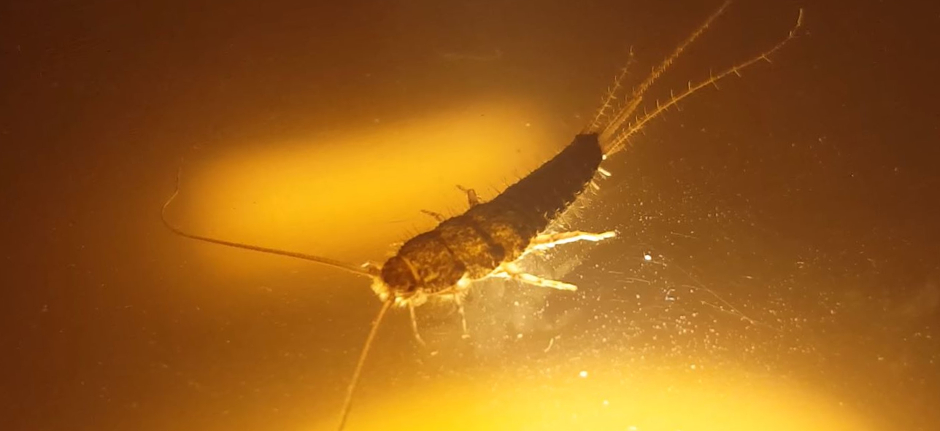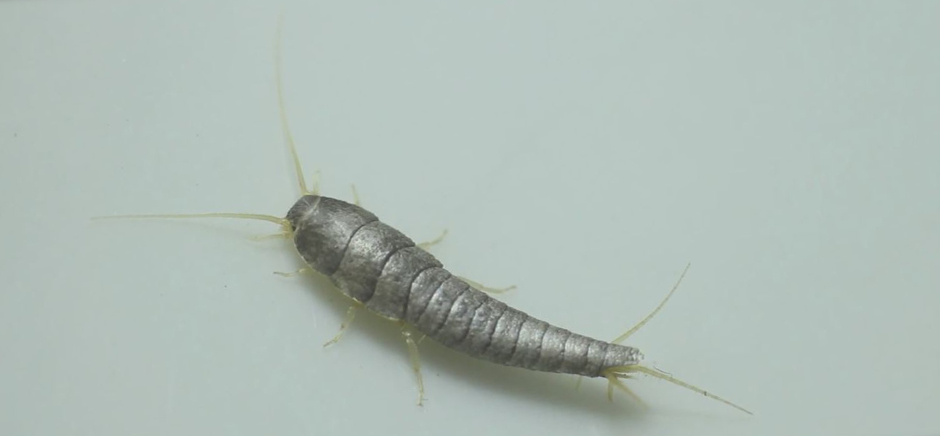How to Get Rid of Silverfish
An educational guide to help you get rid of unwanted Silverfish.
How To Get Rid Of Silverfish
Most people have seen silverfish at some point. These insects are in the shape of a teardrop and either bluish-silver or brown-gray, measuring 12 to 19 millimeters long. They are also recognizable by their long bristles along the rear. Unfortunately for those who don’t want these insects in their homes, silverfish can thrive in most areas. They prefer damp and dark areas, making your bathroom, kitchen, attic, and basement very attractive. They are also commonly found in the boxes stored in sheds and garages. In most cases, you only know that there are silverfish in your home when you see them. Once that happens, you can get ready to get rid of them.

Find The Silverfish
Keeping in mind the types of areas that silverfish prefer, try to figure out where these insects are hiding. Silverfish excrement appears similar to black pepper and is a good indication that they are present. You can also look for yellowish stains or small holes on cereal boxes, fabric, cardboard, and wallpaper. Sometimes, you may also spot a tiny skin cast from when the silverfish shed their skin.
Control Your Home’s Humidity
In addition to preferring damp, dark areas, silverfish nymphs tend to develop more quickly in humid areas. Since their reproductive cycle is already quick, you don’t want to give them the humidity necessary to speed it up even more. An ideal way to prevent this and the silverfish in general is reducing the humidity of your home. Open up the vents in your crawlspace and be sure to include caulking your basement’s baseboards.
Get Rid Of Potential Food
When it comes to silverfish, getting rid of their potential sources of food is much easier said than done. They mostly eat carbs like starches and sugars so some common food sources include dead insects, silk, linen, shampoos, and the glue in books. If you can get rid of these items or at least keep them out of reach of the insects, you will be able to control your issues. Try keeping your home tidy and storing everything in its proper place and you may notice a reduction in the number of silverfish around.
Make Or Buy A Trap
Trapping a silverfish isn’t a permanent solution as you are only catching a single insect or just a handful. While it doesn’t solve your overall problem, you may appreciate the feeling of progress. You can buy a trap designed for silverfish or make your own.

One option is wrapping the exterior of a quart-sized glass jar with masking tape. Put bread at the bottom and set the glass where you think the silverfish are. The silverfish will be able to climb up the exterior thanks to the tape, get inside and eat the bread, but can’t get back out since the glass is slippery.
You can also make a daily disposable trap using old newspaper. Just roll it up, secure the ends using elastic, and get it slightly moist. Place it wherever you see the silverfish before you go to bed. At night, they will enter since the newspaper provides food and shelter. In the morning, throw out the paper without unrolling it or just burn it. You may need to do this multiple nights.
Use Repellents
As with traps, there are a range of repellents available designed to target silverfish. Diatomaceous earth is another great choice and can actually kill multiple other insects as well. The substance is made from ground-up material that was fossilized. Every grain of dust has sharp edges that punctures the exoskeleton of insects so they die and it is harmless to humans. Just be sure to wear a mask when using diatomaceous earth as it can irritate the lungs. You can spread it at night then vacuum it in the morning. Other repellents worth trying include boric acid (which kills the silverfish as well as their eggs), cedar shavings, and spice sachets.
Insecticides
It only takes a quick trip to your local store or a search online to see dozens of insecticides that claim to take care of silverfish. While they may be effective, they only treat the silverfish individually, not the infestation as a whole. You will see some results, but they will only be temporary unless you get rid of the factors making your home attractive to the silverfish.
Additionally, using insecticide always carries some risk as these tend to contain harmful chemicals. You need to be careful with their use, especially around children, the elderly, and pets. To make them worse, many insecticides are damaging to the planet as well. While they are sometimes the ideal solution for your situation, they are best left to professionals.
Experts will know how to safely use the insecticides and the exact quantity needed to keep the area safe while killing and preventing silverfish.
Most people have seen silverfish at some point. These insects are in the shape of a teardrop and either bluish-silver or brown-gray, measuring 12 to 19 millimeters long. They are also recognizable by their long bristles along the rear. Unfortunately for those who don’t want these insects in their homes, silverfish can thrive in most areas. They prefer damp and dark areas, making your bathroom, kitchen, attic, and basement very attractive. They are also commonly found in the boxes stored in sheds and garages. In most cases, you only know that there are silverfish in your home when you see them. Once that happens, you can get ready to get rid of them.

Find The Silverfish
Keeping in mind the types of areas that silverfish prefer, try to figure out where these insects are hiding. Silverfish excrement appears similar to black pepper and is a good indication that they are present. You can also look for yellowish stains or small holes on cereal boxes, fabric, cardboard, and wallpaper. Sometimes, you may also spot a tiny skin cast from when the silverfish shed their skin.
Control Your Home’s Humidity
In addition to preferring damp, dark areas, silverfish nymphs tend to develop more quickly in humid areas. Since their reproductive cycle is already quick, you don’t want to give them the humidity necessary to speed it up even more. An ideal way to prevent this and the silverfish in general is reducing the humidity of your home. Open up the vents in your crawlspace and be sure to include caulking your basement’s baseboards.
Get Rid Of Potential Food
When it comes to silverfish, getting rid of their potential sources of food is much easier said than done. They mostly eat carbs like starches and sugars so some common food sources include dead insects, silk, linen, shampoos, and the glue in books. If you can get rid of these items or at least keep them out of reach of the insects, you will be able to control your issues. Try keeping your home tidy and storing everything in its proper place and you may notice a reduction in the number of silverfish around.
Make Or Buy A Trap
Trapping a silverfish isn’t a permanent solution as you are only catching a single insect or just a handful. While it doesn’t solve your overall problem, you may appreciate the feeling of progress. You can buy a trap designed for silverfish or make your own.

One option is wrapping the exterior of a quart-sized glass jar with masking tape. Put bread at the bottom and set the glass where you think the silverfish are. The silverfish will be able to climb up the exterior thanks to the tape, get inside and eat the bread, but can’t get back out since the glass is slippery.
You can also make a daily disposable trap using old newspaper. Just roll it up, secure the ends using elastic, and get it slightly moist. Place it wherever you see the silverfish before you go to bed. At night, they will enter since the newspaper provides food and shelter. In the morning, throw out the paper without unrolling it or just burn it. You may need to do this multiple nights.
Use Repellents
As with traps, there are a range of repellents available designed to target silverfish. Diatomaceous earth is another great choice and can actually kill multiple other insects as well. The substance is made from ground-up material that was fossilized. Every grain of dust has sharp edges that punctures the exoskeleton of insects so they die and it is harmless to humans. Just be sure to wear a mask when using diatomaceous earth as it can irritate the lungs. You can spread it at night then vacuum it in the morning. Other repellents worth trying include boric acid (which kills the silverfish as well as their eggs), cedar shavings, and spice sachets.
Insecticides
It only takes a quick trip to your local store or a search online to see dozens of insecticides that claim to take care of silverfish. While they may be effective, they only treat the silverfish individually, not the infestation as a whole. You will see some results, but they will only be temporary unless you get rid of the factors making your home attractive to the silverfish.
Additionally, using insecticide always carries some risk as these tend to contain harmful chemicals. You need to be careful with their use, especially around children, the elderly, and pets. To make them worse, many insecticides are damaging to the planet as well. While they are sometimes the ideal solution for your situation, they are best left to professionals.
Experts will know how to safely use the insecticides and the exact quantity needed to keep the area safe while killing and preventing silverfish.
About Us
We are the Pest Education Network, a non-profit organization that focuses on wildlife and pest removal education. Our approach utilizes Integrated Pest Management, a strategy advocating prevention and humane methods.


